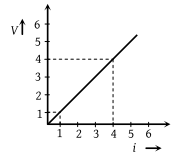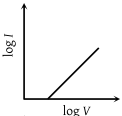E denotes electric field in a uniform conductor, I corresponding current through it, Vd drifts velocity of electrons and P denotes thermal power produced in the conductor, then which of the following graph is incorrect :
(1) 
(2) 
(3) 
(4) 




The two ends of a uniform conductor are joined to a cell of e.m.f. E and some internal resistance. Starting from the midpoint P of the conductor, we move in the direction of current and return to P. The potential V at every point on the path is plotted against the distance covered (x). Which of the following graphs best represents the resulting curve
(1)
(2)
(3)
(4)
The resistance Rt of a conductor varies with temperature t as shown in the figure. If the variation is represented by , then
(1) α and β are both negative
(2) α and β are both positive
(3) α is positive and β is negative
(4) α is negative and β are positive
Variation of current and voltage in a conductor has been shown in the diagram below. The resistance of the conductor is :
(1) 4 ohm
(2) 2 ohm
(3) 3 ohm
(4) 1 ohm
Resistance as shown in figure is negative at
(1) A
(2) B
(3) C
(4) None of these
For a cell, the graph between the potential difference \((V)\) across the terminals of the cell and the current \((I)\) drawn from the cell is shown in the figure below. The emf and the internal resistance of the cell are, respectively:

| 1. | \(2~\text{V}, 0.5 ~\Omega\) | 2. | \(2~\text{V}, 0.4 ~\Omega\) |
| 3. | \(>2~\text{V}, 0.5 ~\Omega\) | 4. | \(>2~\text{V}, 0.4 ~\Omega\) |
The graph which represents the relation between the total resistance R of a multi-range moving coil voltmeter and its full-scale deflection V is :
1. (i)
2. (ii)
3. (iii)
4. (iv)
When a current I is passed through a wire of constant resistance, it produces a potential difference V across its ends. The graph drawn between log I and log V will be
(1)
(2)
(3)
(4)
The V-I graph for a conductor at temperature T1 and T2 are as shown in the figure. is proportional to :
(1)
(2)
(3)
(4)
A cylindrical conductor has a uniform cross-section. The resistivity of its material increases linearly from the left end to the right end. If a constant current is flowing through it and at a section distance x from the left end, the magnitude of electric field intensity is E, which of the following graphs is correct :
(1)
(2)
(3)
(4)























